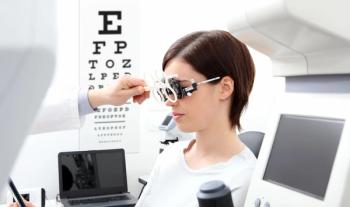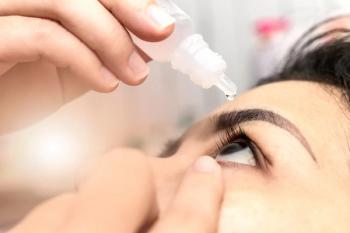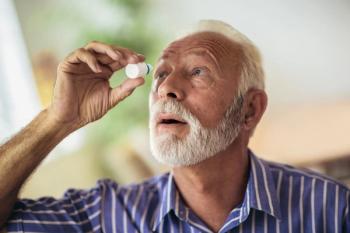
MOJAVE phase 3 study results published
The second pivotal phase 3 data on NOV03 (perfluorohexyloctane) show that NOV30 consistently met primary endpoints for signs and symptoms of dry eye disease associated with Meibomian gland dysfunction.
Bausch + Lomb and Novaliq announced the results from MOJAVE, the second pivotal phase 3 trial for NOV03 (perfluorohexyloctane) was published in the American Journal of Ophthalmology, according to a
“In addition to meeting both primary sign and symptom efficacy endpoints, NOV03 was shown to be very well tolerated in the MOJAVE study," Yehia Hashad, M.D., executive vice president, Research & Development and chief medical officer, Bausch + Lomb said in the release.1 "These are all critical factors that must be considered when determining a treatment plan for someone with a chronic and progressive condition like dry eye disease associated with Meibomian gland dysfunction. Excess tear evaporation is a major factor in dry eye disease associated with Meibomian gland dysfunction, which remains largely unaddressed.”
DED affects millions of Americans and is one of the most common
MOJAVE study
The data from the Phase 3, multicenter, randomized, hypotonic saline-controlled, double masked MOJAVE study was based on results from 620 subjects aged 18 years and older who were randomized to either receive treatment with NOV03 four times daily or hypotonic saline solution four times daily (n=311 NOV03; n=309 saline).
The two primary endpoints were change from baseline at Week 8 (Day 57 ± 2) in total corneal fluorescein staining (tCFS) and eye dryness Visual Analog Scale (VAS) score. Key secondary endpoints included change from baseline in eye dryness VAS score and tCFS at Week 2 (Day 15 ± 1) and eye burning/stinging VAS score and central corneal fluorescein staining (cCFS) at Week 8. Significant improvements vs. hypotonic saline solution were seen as early as day 15. Data highlights include:
Primary endpoints
- At Week 8, reduction from baseline in tCFS was statistically greater in the NOV03 arm compared to the control saline group (least-squares [LS] mean treatment difference, -1.2 (95% confidence interval [CI]: -1.7, -0.8) (P < .001)).
- At Week 8, VAS dryness score was statistically significantly improved in the NOV03 arm compared to control group (LS mean treatment difference, -10.2 (95% CI: -14.4, -6.1) (P < .001)).
Key secondary endpoints
- At Week 2, tCFS and VAS dryness score were statistically significant compared to saline, with an LS mean treatment difference (95% CI) for change from baseline in tCFS of -0.6 (-1.0, -0.2) (P = .001) and VAS score of -7.8 (-11.3, -4.3) (P < .001).
- At Week 8 VAS burning/stinging score and cCFS also favored the NOV03 group, with an LS mean treatment difference (95% CI) for change from baseline in VAS burning/stinging score of -7.3
(-11.3, -3.4) (P < .001) and cCFS of -0.3 (-0.5, -0.2) (P < .001).
In the study, NOV03 was well tolerated with few subjects experiencing ocular adverse events (AEs) (12.9% NOV03 group, 12.3% control group) or treatment-related ocular AEs (6.4% NOV03 group, 6.8% control group). Most AEs were mild to moderate in severity. The most common AEs (incidence ≥ 1%) experienced in the NOV03 group were blepharitis, conjunctival hyperemia, conjunctival papillae, ocular hyperemia, blurred vision, hordeolum (stye), and visual acuity reduction. No patients in either the NOV03 group or saline group had an ocular AE that led to treatment discontinuation or withdrawal from the study.
Previous NOV03 (perfluorohexyloctane) ophthalmic solution study result publications
In 2019, Bausch + Lomb acquired an exclusive license for the commercialization and development of NOV03 in the United States and Canada. Results from the pivotal Phase 2 trial (SEECASE) were published in Cornea in September 2021. Data from the first pivotal Phase 3 trial (GOBI) were presented at the American Society of Cataract and Refractive Surgery (ASCRS) annual meeting in Washington, D.C. on April 24, 2022. Data from the second pivotal Phase 3 trial (MOJAVE) were presented at the Association for Research in Vision and Ophthalmology (ARVO) annual meeting in Denver on May 2, 2022. The clinical program for NOV03 concluded with the completion of a multi-center, open-label, single-arm, 12-month safety extension trial (KALAHARI). In September 2022, Bausch + Lomb and NOV03 announced that the U.S. FDA had accepted the NDA filing for NOV03 and assigned a PDUFA action date of June 28, 2023.
References:
1. News releases. Bausch + Lomb News Releases. https://www.bausch.com/news/releases/?id=143. Accessed March 22, 2023.
2. NOV03 for Signs and Symptoms of Dry Eye Disease Associated With Meibomian Gland Dysfunction: the Randomized Phase 3 MOJAVE Study. American Journal of Ophthalmology. https://www.ajo.com/article/S0002-9394%2823%2900098-3/fulltext. Published March 20, 2023. Accessed March 22, 2023.
3. National Eye Institute. Dry Eye. Last updated April 8, 2022. Accessed December 21, 2022. https://www.nei.nih.gov/learn-about-eye-health/eye-conditions-and-diseases/dry-eye
4. Leonardi, A., Modugno, R. L., & Salami, E. (2021). Allergy and Dry Eye Disease. Ocular immunology and inflammation, 29(6), 1168-1176. https://doi.org/10.1080/09273948.2020.1841804.
5. Lemp, MA, Crews, LA, Bron AJ. (2012). Distribution of Aqueous-Deficient and Evaporative Dry Eye in a Clinic-Based Patient Cohort: a retrospective study. Cornea, 31(5), 472-478. https://journals.lww.com/corneajrnl/Abstract/2012/05000/Distribution_of_Aqueous_Deficient_and_Evaporative.2.aspx
6. Geerling G, Baudouin C, Aragona P, et al. (2017). Emerging strategies for the diagnosis and treatment of meibomian gland dysfunction: Proceedings of the OCEAN group meeting. The Ocular Surface,15(2): 179-192. https://doi.org/10.1016/j.jtos.2017.01.006
Newsletter
Want more insights like this? Subscribe to Optometry Times and get clinical pearls and practice tips delivered straight to your inbox.
















































.png)


